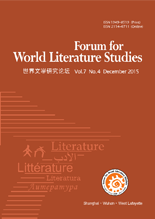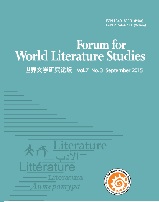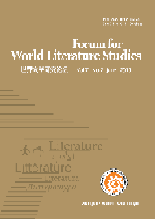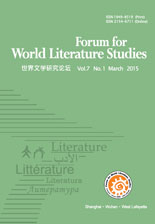A Comparative Study on the Man-Nature Relationship and Its Presentation in Chinese and British Nature Poetry
Su Hui
School of Chinese Language and Literature, Central China Normal University
152 Luoyu Road, Wuhan 430079, China
Email: [email protected]
Li Yinbo
College of Arts & Law, Wuhan University of Technology
122 Luoshi Road, Wuhan 430070, China
Email: [email protected]
Abstract Poetry on nature has always been a sparkling star in Chinese literature as well as in British literature. Chinese and British nature poetry share similar characteristics such as the pursuit of freedom and the attachment of certain emotions to natural sceneries. Meanwhile, they are also greatly different owing to the differences in cultural background, national characters and psychologies, philosophies and aesthetic traditions. This paper aims to explore the differences between Chinese and British nature poetry in terms of their concern with the relationship between man and nature and its presentation. Chinese and British nature poets appeal to different things in terms of the relationship between man and nature. In Chinese nature poems, the poet always pursues the harmony between man and nature, the self being forgotten; while in British nature poems, the scenery is regarded as a symbol of emotions, the self always being foregrounded. Chinese and British nature poetry are also different in their composing principles and methods. Generally speaking, analogy and narration are the main practice in ancient Chinese natural poetry writing, whereas personification and dramatic narration in English. In British poems, since the speaker is narrating, “the sceneries are losing their concreteness and directness with the speaker’s constant intervention” and they are presented in a single line. Chinese nature poems are the exemplification of “dramatic narration.” The sceneries are presented directly to the readers, without the interference of the poet, and with the feature of loose arrangements, multi- levels and changing perspectives.
Key words Chinese nature poetry; British nature poetry; Man-Nature Relationship
Author Su Hui teaches foreign literature at the School of Chinese Language and Literature, Central China Normal University, Wuhan, P.R.China. Her interests in scholarship include American literature, comparative literature, and aesthetics of comedy. Dr. Li Yinbo is associate professor at the College of Arts & Law, Wuhan University of Technology (Wuhan 430070, China), specializing in comparative literature and intercultural communication.
Poetry on nature has always been a sparkling star in Chinese literature as well as in British literature, but it has gone through different phases of developments. Chinese nature poetry can be dated back to the period of Wei Jin Southern and Northern Dynasties (4 th -5 th century), and prospered in Tang and Song Dynasties. Representative Chinese nature poets, namely, Tao Yuanming, Xie Lingyun, Meng Haoran, Wang Wei, Li Bai, Du Fu, Bai Juyi, Su Shi and Lu You had written a substantial number of brilliant nature poems. British nature poetry appeared in the Renaissance, and prospered in the Romantic Movement. The representative poets were Spencer, Pope, Wordsworth, Coleridge , Shelley, Keats, Byron and so on.
Chinese and British nature poetry share similar characteristics such as the pursuit of freedom and the attachment of certain emotions to natural sceneries. Meanwhile, they are also greatly different owing to the differences in cultural background, national characters and psychologies, philosophies and aesthetic traditions. This paper aims to explore the differences between Chinese and British nature poetry in terms of their concern with the relationship between man and nature and its presentation. I Chinese and British nature poets appeal to different things in terms of the relationship between man and nature. In Chinese nature poems, the poet always pursues the harmony between man and nature, the self being forgotten; while in British nature poems, the scenery is regarded as a symbol of emotions, the self always being foregrounded. Such difference can be clearly seen if we compare Wordsworth’s “Lines Written in Early Spring” with Wang Wei’s “The Deer Enclosure” and “The Twitter-Valley.” In the first two stanzas in “Lines Written in Early Spring”: While in a grove I sate reclined, In that sweet mood when pleasant thoughts, Bring sad thoughts to the mind.
To her fair works did nature link The human soul that through me ran; And much it griev’d my heart to think What man has made of man. Wordsworth contrasts nature’s kindness with man’s cruelty. The natural scenery is subsidiary to the speaker’s thoughts and emotions. The speaker is not immersed in the intimacy with the nature. Instead, by associating beautiful natural environment with evil social environment, he ponders over the problem of “what man has made of man.” For readers, their immediate aesthetic target is the emotion, not the scenery. Similarly, though the west wind, the swift cloud, the wave and the hail in Shelley’s “Ode to the West Wind,” and the nightingale, the forest and the night in Keats’s “Ode to a Nightingale” all appear as independent imageries, they carry certain emotions of the speaker or certain symbolic significance. There is apparently a gap between the speaker and nature, where the speaker is clearly aware that man isn’t materialized and nature isn’t personified. After a temporary communication, man and nature have returned to their respective different world. What Keats felt after the nightingale left is a good example.
Forlorn! the very word is like a bell
To toll me back from thee to my sole self!
Adieu! the fancy cannot cheat so well
As she is famed to do, deceiving elf.
Adieu! adieu! thy plaintive anthem fades
Past the near meadows, over the still stream,
Up the hill-side; and now ‘tis buried deep
In the next valley-glades:
Was it a vision, or a waking dream?
Fled is that music: — do I wake or sleep?
With several “adieu”s, the nightingale’s singing flows “past the near meadows,” “over the stream,” “up the hill-side” until it is “buried deep in the next valley- glades.” The speaker suddenly awakens to the reality though he still lingers over the dreamlike scene. What predominates in him is reason, not fantasy.
In Wang Wei’s(王维) two poems, “The Deer Enclosure”(鹿柴) and “The Twitter-Valley”(鸟鸣涧):
The Deer Enclosure
The hills are empty and nobody is sight,
But the human voices can be heard.
The dark woods can’t hide the late sunset,
Which shines onto the green mosses on the ground.
The Twitter-Valley
Idle man can hear the fall of laurel flowers,
Quiet night can make spring hills empty.
When moon comes out it startles the hill-birds,
Which twitter and twitter in the vernal valley.
the poet creates a serene atmosphere where only the nature is seen. By now, the poet has rid himself of the burdens of all sorts of thoughts. He seems to have forgotten about himself, only contemplating the current scene, without any intellectual interference. It is under such circumstance that he acquires special hearing and eyesight, and is able to hear the unheard and see the unseen. With the sensitiveness, he obtains the breath of the universe and feels the rhythm of the nature, thus combining the subjective with objective. At the moment, the “self” doesn’t go into the nature, while the nature doesn’t enter the “self.” The nature and “I” are intermingled. The self is negated(no self), meanwhile it is acknowledged, because the individual is immersed into the universe, the self is made immortal.
Lines like this in Chinese nature poetry are numerous. For example, “The sparse shadows of its branches are slant across the clear shallow water, / A slight fragrance of its flowers floats with wind under moon in twilight”, from Lin Hejing’s( 林 和 靖)“To the Plum Blossoms in a Garden”( 山 园 早 梅 ), is an image of the plum in early spring. Seeing its lonely shadow in the water, the fragrant plum feels sad, yet admires itself. Vague and sparse, it is ignored by people, but wins the heartfelt appreciation of the poet. It is a plum, but it is more like a human being, a noble person isolated from the world and enjoying spiritual satisfaction. This is exactly the image of the poet himself who has been secluding himself in Gushan Mountain of Westlake. The imagery produced from the unity of the self, and the nature is neither a metaphor nor a symbol, but describes a state when the heart seems to have ceased beating and the self is released from the body to blend with the myriad of things in the universe. The poet has transcended the reality by obtaining great freedom in spirit and coming to the highest stage in aesthetics. The different relationship between the self and the nature reflected in Chinese and British nature poetry is closely related to the different natural views.
In China, the prevailing idea is the harmony between man and nature. The formation of this idea is associated with the Chinese way of living and their living environment. As early as the New Stone Age, the farming economy had been established and for several thousand years, the self-sufficing economy was stable and prosperous. Therefore, people greatly relied on natural environment, and were sensitive to any delicate changes in the natural world, as they were desiring for the intimacy with the nature. In Chinese philosophy, although there was preaching of “the division of man and nature” and “man’s conquering of nature”, what dominates the mentality of common Chinese people is still the idea of harmony between man and nature, the communication between man and nature. This idea is embedded in Confucianism, Taoism and Buddhism. Therefore, it becomes an integral part of Chinese natural view and promotes the formation and development of their aesthetic awareness of nature.
The flourishing of Chinese nature poems and the formation of leading ideas are closely related to Taoism. The core of Laozi and Zhuangzi’s philosophy is “Tao”( 道 ), which is the law of the universe and the cause of all changes in the universe. The highest spiritual state is the unity with “Tao”, that is, through cultivating the vacancy and stillness of the mind, the subject obtains a mind free from affectation and all world value judgments. To observe everything in the universe with this natural mind, “I” coexist with the universe and everything and “I” are a unity, the object mingling with the subject’s mind.
There are similar ideas in Confucianism. The Confucianists argue that the essence of the nature exists in human mind. Man in the ethical sense echoes the nature, the source of ethics. They advocate “Troubled, improve yourself; valued, improve the world”, that is, one should live in poverty and seek comfort in poverty, which also implies the idea of “obeying nature.” The Buddhists advocate refraining from the earthly world. They hold the view that the sublime state of life is the emptiness and purity of the mind, which is a returning to the nature through practice of meditation. According to Zen Buddhism, experiencing a moment of awakening in this life is of central importance. It is at this moment that one gets his eternity. Therefore, freeing themselves from the captivity of language, words, concepts and thoughts, Zen Buddhists express those that are supposed to be unspeakable in an intuitive way. From different perspectives, Confucianism, Taoism and Buddhism all expound on the idea of the harmony between man and nature. This idea is deeply rooted in the mind of ancient Chinese intellectuals, particularly exerting great influence on nature poets’ aesthetic and artistic views. When the poets try to express their affection towards the nature, the self and the nature are harmoniously mingled with each other. In western philosophy, because of the influence of scientific rationality and humanistic ideas, the relationship between man and nature is relatively estranged. Ancient Greeks were used to posing natural beauty as something opposite to themselves, and attempted to analyze it in an objective way.
The Melisian School broke the shackles of mythology and tried to explain the formation and development of everything in the natural world in terms of matter and rationality, but they seldom touched upon the relationship between man and nature. Later on, Protagoras put forward the proposition that “man is the measure of all things”, placing man as the core of the universe, thus started the tradition of humanism. Idealists such as Socrates and Plato regarded nature as the embodiment of God or concepts. They argued that man can only know the surface of the nature while its inherent laws belong to the other world. Aristotle saw nature in a mechanical materialistic way. Nature to him is an intellectual world which can be understood, but it’s hard to be experienced emotionally. In the Middle Ages, western culture was dominated by Christianity. According to Christianity teachings, man should believe in God, indulging in the nature would affect the perfection of the soul. Ever since Renaissance, the beauty of nature has been receiving more and more attention. The waves of “the discovery of man” had washed away the mythological remains covering the nature. The brilliant beauty of nature was a shock to people in the modern west. The practice of praising the nature was temporarily replaced by Neoclassical rationality in the 17 th century, but the enlighteners in the 18 th century declared that “we should return to the nature”. With the advent of the Romantic Movement in the 19 th century, nature became an independent target of aesthetics and had an important position in literary works. However, nature poets often appreciate natural beauty from the relationship between thinking and being, focusing on exploring the nature of everything in the universe. They tend to explain the diverse and mysterious natural phenomenon with monism, as a result of which for them, the subject is relatively independent from the object. This explains why the mind resonates with the nature and the self and the nature intermingled harmoniously in Wang Wei’s poems on nature, while there’s much reasoning and thinking in Wordsworth’s poems.
II
Chinese and British nature poetry are also different in their composing principles and methods. Generally speaking, analogy( 拟 物 主 义 ) is the main practice in ancient Chinese natural poetry writing, whereas personification (拟人主义)in English. Chinese nature poets tend to be impersonal. Things exist not because of “the self”, but the inherent laws. Therefore, the truth and beauty lie in the existence. Both the things and “the self” can be either subjective or objective. British nature poets tend to be more personal or subjective, explaining the world with “the self” and abstract concepts. The value of their poetry lies in the ontological level, as a consequence of which there is always the color, the emotions and values of “the self” involved and there is a clear-cut division between the subjective and objective.
For instance, Shelley’s “Ode to a Skylark” and Du Fu’s “A Quatrain” both present the image of birds. In “Ode to a Skylark”, the speaker addresses the skylark in apostrophe: “Hail to thee, blithe Spirit! / Bird thou never wert, / That from Heaven, or near it, / Pourest thy full heart / In profuse strains of unpremeditated art. ”Here, the skylark is imagined as a creature that understands man and stands right in front of the speaker, listening to him. It is the embodiment of pure happiness and can sing heavenly hymns which remind the speaker of the past old times where there was no pain, no sentiment and full of laughter. The skylark is personified.
In Du Fu’s(杜甫)“A Quatrain”(绝句), analogy is used: “Two golden orioles sing amid the willows green; A flock of white egrets flies into the sky. My window frames the snow-crowned western mountain scene; My door says often to east-going ship goodbye.” A beautiful picture is painted in the first couplet: the thatched cottage is surrounded by willows, on the branches of which a couple of orioles were singing and a flock of white egrets is flying in the sky. Both singing orioles and flying white egrets bring energy and happiness. This quatrain was written by Du Fu when he returned to his thatched cottage in Chengdu after the An Lushan-Shi Siming Rebellion and caught sight of such vibrant views in front of him. In this poem, the poet is just like a painter, without interfering with the picture and the sceneries are not personified. But reading the lines, readers may feel the poet has become a singing oriole or a flying white egret. This is the analogy is Chinese poetics. The scenery serves as a mirror to the mind.
T. S. Eliot once made a distinction between “narration” and “dramatic narration” in poetry. “Narration” is a top-down metaphor of the material, is a subjective projection of the material; “Dramatic narration” is an objective projection of feelings. Such a distinction is proper to be applied to tell the differences between Chinese and British poems on nature. In British poems, since the speaker is narrating, “the sceneries are losing their concreteness and directness with the speaker’s constant intervention” (Ye Weilian 89) and they are presented in a single line. To explain this, Mr. Ye Weilian gave an example of Wordsworth’s “Tintern Abbey.” He pointed out that three quarters of this poem is the explanation of how the outside world affects the mind, or the explanation of how the mind and the nature feel and supplement each other. Nature is the “babysitter, mentor and parent” of his moral being (Ye Weilian 88). Meanwhile, the way the speaker presents the sceneries shows that he is directing the readers to get in touch with the sceneries following his eyes, not interweaving time and space, which is quite similar to the one-way transparency in western painting. Either the readers or the poet is separated from the nature and is not able to merge into the nature.
Chinese nature poems are the exemplification of “dramatic narration”. The sceneries are presented directly to the readers, without the interference of the poet, and with the feature of loose arrangements, multi-levels and changing perspectives. For example, in “On the West Stream of Chuzhou” (滁州西涧) from Wei Yingwu(韦应物) in Tang Dynasty: “Alone I like the riverside where green grass grows / And golden orioles sing amid leafy trees. / When showers fall at dusk, the river overflows; / A lonely boat athwart the ferry floats at ease”, all the images are independent of each other. There isn’t a sure logic relationship or a fixed order among the “green grass”, “riverside”, “orioles”, “showers”, “ferry” and “boat”. They come into readers’ view alternatively, free from the interference of the speaker’s feelings. Meanwhile, these seemingly irrelevant images form a complete picture in readers’ mind and evoke their aesthetic pleasure. The readers’ interpretation can be accomplished from every possible perspective and without the limitation of time and space.
There are various factors leading to such differences between Chinese and English nature poems. This paper will focus on the following two factors. First, in terms of aesthetics, the principle of “vitality infusion” is always followed in appreciating and composing a piece of artistic work in the west, that is, the subject has to infuse vitality into the aesthetic object. Kant maintains that we should “transfer our reverence for the object to the nature” (Qtd. Wu Lifu 563) in his Critique of Judgement. Hegel holds a similar view that “natural beauty is merely a reflection of the beauty in mind, an incomplete and imperfect state”(Hegel 3), its perfection could be reached when infused vitality by human mind. That’s why Hegel maintains that “artistic beauty is above natural beauty”. Influenced by Kant and Hegel’s ideas, German aesthetician the Vischers and Lipps put forward the notion of “empathy.” Empathy is the projection of emotions on the outside world. Aesthetic empathy, in Lipps’ words, is “infusing vitality into reality” (qtd. Zhu Guangqian 624). As we can see, either in Kant and Hegel’s aesthetics, or in Lipps’ notion of empathy, the focus is always the subject, while the object is completely passive. With such aesthetic view, personification is generally employed by British nature poetry writing. The nature is personified and what is foregrounded is the image of “I,” who directs readers to observing nature.
It is a different picture in Chinese nature poetry writing. In Chinese aesthetics and philosophies, life of everything is always thought to originate from nature; everything in nature resonates with human breathing. The aesthetic practice is not only on the projection of their emotions, but also the bilateral communication between nature and themselves. This can be achieved by a technique in the ancient Chinese poetry writing — Bi Xing (比兴). “Bi” is to attach certain emotions to things; “Xing” is to trigger certain feelings when seeing things. “BiXing” lays emphasis on the bilateral communication between the subject and the object, never separating the person from the thing he attaches emotions to. By employing this technique in poetry writing, it is possible to connect several imageries, which share similarities to a certain extent. For example, in Ying Yang’s “On Departure”: “Clouds float above the ocean at sunrise, / over the mountain at sunset. / Soldiers at war miss their hometown, / but words of sorrow can’t be said.” “soldiers at war” are compared to “floating clouds”, their homesickness being foregrounded. Imageries connected by “Xing” are not necessarily connected with each other, as “By riverside are cooing / A pair of turtledoves” and “ A good young man is wooing / A fair maiden he loves”. It is the technique “BiXing” that has made the juxtaposition of imageries possible in ancient Chinese poetry.
Second, in terms of the features of the language and characters, ancient Chinese language is loosely structured in grammar, with a flexible part of speech; while there are strict syntactic rules in English language, with changes of part of speech, number, person and tense. This is one of the important reasons leading to the different ways of presenting imageries in different structures in Chinese and British nature poems.
As in Meng Haoran’s (孟浩然)“Passing the Night on a River in Jiande” (宿建德江): “I guide my boat to mooring by a misty islet, / With the setting sun, a traveler’s sorrows revive. / Wilds so vast, the sky stoops to the trees; / The river so clear, moon close to man.” The original Chinese word “xin,” “di” and “jin” can be used as adjectives as well as verbs. When “xin” is an adjective, “ke chou xin” means the traveler feels some new sorrows; when “xin” is a verb, it means “his sorrows revive”. When “di” is an adjective, “tian di shu” means the sky is lower than the trees; when “di” is a verb, it means “the sky stoops to the trees”. When “jin” is an adjective, “yue jin ren” means the moon is “close to” man; when “jin” is a verb, it means the moon approach man. When used as adjectives, these words show a static beauty; when verbs, dynamic. Meanwhile, some prepositions and conjunctions are omitted to vague the connection between imageries, leaving great space for readers to imagine. In the original Chinese version, there is no “by” between “moor” and “a misty islet,” and no conjunctions between “ye kuang” and “tian di shu,” “jiang qing” and “yue jin ren.”
There are quite different features in English language. The strict syntactic rules and the use of various modifiers set boundaries among imageries, as a result of which they are developed and presented in a linear way from a certain perspective. For example, in the first two lines of Wordsworth’s “My Heart Leaps up,” “My heart leaps up when I behold / A rainbow in the sky,” “in” connects “a rainbow” and “the sky,” indicating the constraint. “When” connects “my heart leaps up” and “I behold a rainbow,” indicating the reasons of hearting leaping up. When there is such a clear and strict boundary between imageries, the independence and objectivity of the sceneries is invaded, which is helpful to produce ambiguity and visual effects.
In the early 20 th century, English poets started to learn from ancient Chinese poetry, and have developed some similar techniques. The typical example is Imagism. However, even in Pound, who very consciously imitates Chinese poems, we find concerns and perspectives quite different from his Chinese counterpart. This question will be further discussed in other papers.
Works Cited
Hegel. Esthetics. Vol.I. Beijing: The Commercial Press, 1979.
Wu Lifu. Selected Works of Western Literary Theory. Shanghai Translation publishing house, 1979.
Ye Weilian. Chinese Poetics. SDX joint publishing company, 1992.
Zhu Guangqian. History of Western Esthetics.Vol. II. Beijing: people’s Literature Publishing House, 1979.
Recommended article:
- Ethical Power from “the Human Heart by Which We Live”
- Understanding of Cosmopolitanism in Georgian Literary Thinking: From Goethe to V
- Fictions of Empire and the (Un-)Making of Imperialist Mentalities: Colonial Disc
- Usury and Ethical Anxiety in Timon of Athens
- Reading Levinasian Notions of Alterity and the Ethics of Place in Ford Madox For
Column Navigation
NEWS
- General introduction DOI 10.
- A Comparative Study on the Man
- Ethical Power from “the Human
- An Islamic Reading of Rudyard
- Understanding of Cosmopolitani
- Fictions of Empire and the (Un






